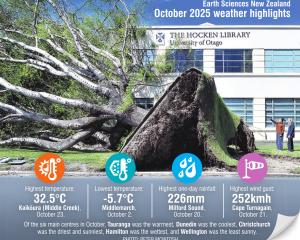The ministry confirmed it was consulting the companies - the Otago Daily Times understands three or four engineering businesses are involved - before making a decision on what to do with one of Dunedin's most distinctive and central heritage buildings.
Deputy secretary of higher courts Robert Pigou said this week because it was such a complex building and required a very detailed approach, six months had been allowed for that process.
''We are also working closely with the Historic Places Trust and expert advisers, and this all adds to the time it will take us to make a final decision.''
The ministry's final intention and a detailed costing would be known by the end of May, he said.
The main part of the courthouse, built about 1902, was closed in December 2011 after an engineer's assessment found the building's tower was below the strength legally required by the Building Act.
The tower could potentially collapse in a moderate earthquake, posing a risk to the northern part of the building, which housed two courtrooms and other facilities.
The civil and family courts have been moved to another building and everyone involved in criminal trials for more than a year has had to make the 440km round trip to Invercargill.
New jury trial facilities in High St, Dunedin, are not due to open until July.
Asked why the process was taking so long, when other buildings around Dunedin vulnerable to earthquake damage were assessed and strengthened more quickly, Mr Pigou said there were several issues.
A geotechnical assessment was not done until last September because the immediate priority after closing the tower area was to get court services running again as quickly as possible.
''Once we had services working well, we turned our attention to the strengthening work.''
Now, the issue was selecting the appropriate strengthening options and accurately costing their implementation.
''Because there are a range of opinions, and therefore costs, the challenge is to get some united views about the specific type of remedial work needed and greater certainty around what it will cost.''
He declined to go into any details of the costs involved, because they were still commercially sensitive.
The ministry has so far given no commitment to fully reoccupying the building.
Mr Pigou did not respond to a question about what price would make them reconsider strengthening the building.
Asked why the work simply did not go ahead after an initial engineering assessment, which suggested the strengthening work could be done for $650,000, he said further investigation had shown there were more issues with much of the heritage building stock.
''In our experience, it is not cheap or straightforward to strengthen these buildings, especially if they are heritage 1 [category] buildings like [in] Dunedin.
''For the Masterton court, for example, the initial estimate was $300,000. The final detailed cost estimate was $3.5 million.''
The cost of work required to strengthen the Oamaru courthouse is being reviewed after a public outcry followed a ministry estimate of up to $6 million to bring the building up to 67% of the building standard.
The initial estimate there was $350,000.












